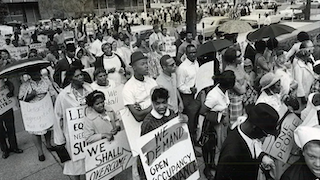
Protesters gathered in front of Waterloo City Hall on June 4, 1966, after a seven-block march. The crowd sang “We Shall Overcome” and presented Mayor Lloyd Turner with a list of 12 grievances. Demonstrators also heard a brief speech by the mayor. Photo courtesy of The Des Moines Register
Jan/Feb 2024 (Volume 16, Issue 1)
By Jerry Harrington
More than half a century ago, an Iowa governor launched a crusade across the state to bridge racial divisions with a simple message: love thy neighbor.
That governor — Harold Hughes — used the intensity of his personality, his Christian vision and his powerful deep bass voice to appeal to a mostly white audience of Iowans to empathize with the plight of their fellow Black citizens. Generated by multiple conversations Hughes had with members of Iowa’s Black communities, this effort — called the Crisis Conferences — was a rallying cry to Iowans to understand racial prejudice and how it has impacted generation after generation of Black Iowans.
It was an act of leadership dedicated to curbing racial conflict in tense times and bringing people together.
Urban conflicts in Iowa
In the mid-1960s, the civil rights movement had shifted from abolishing Jim Crow laws and customs in the American South and moved to northern urban centers where racism had long denied Blacks the riches of the American Dream in a time of rising expectations. Beginning in 1965 with the race riot in the Los Angeles Watts community, urban racial upheavals became common over the next several years, especially during the long, hot summers.
These clashes were often instigated by unemployed Black youths in conflict with mostly white police forces. In 1966 there were 11 major race riots and 30 minor disturbances throughout the United States. One substantial conflict took place in Detroit, where 43 people died in 1967.
Iowa was not immune to these conflicts which occurred in such cities as Des Moines and Waterloo. In July 1966, Black youths in Des Moines clashed with police in a violent confrontation caused by boredom, bad housing, heat and other factors “intensified by poor police handling,” according to reports. Some 200 to 300 Black young people pelted police with rocks and bottles, damaging five squad cars and wrecking streetlights before local Black leaders managed to cool the crowd. Another incident took place in Des Moines in September that year with more than two dozen Black people near Drake University during a window-breaking spree.
The conflicts continued in the summer of 1967 in Waterloo, where the city’s Black population was concentrated on the east side. Several nights of violence began on July 7 when police accused a Black youth of stealing hubcaps. Clashes between Black crowds and local police continued when, on the third night, gangs of youths ran through downtown Waterloo starting fires, smashing windows, looting stores and pelting cars with stones. Police arrested 75 people. The all-white police force, resorting to racial slurs and billy clubs, only contributed to the problem.
Iowa Gov. Harold Hughes, by 1967 in his third two-year term, initially responded with condemnation of these Black youths, calling their actions “an irresponsible act by a group of delinquents.” Seeking a more in-depth perspective, he sent former prison chaplain Father Cyril Engler to Waterloo to evaluate the situation. Talking to several hundred people, Engler cited promises to the Black community of more open housing and on-the-job training that never materialized. Describing a deeply divided city along racial lines, Engler pointed to a chief of police and mayor who spoke only of “rigid police control” and “nothing in the way of long-term solutions.” He concluded that nothing could be solved “unless there is an obvious sincere desire on the part of residents” to reconcile differences.
TO READ THE ENTIRE STORY AND OTHER FASCINATING STORIES ABOUT IOWA HISTORY, subscribe to Iowa History Journal.
